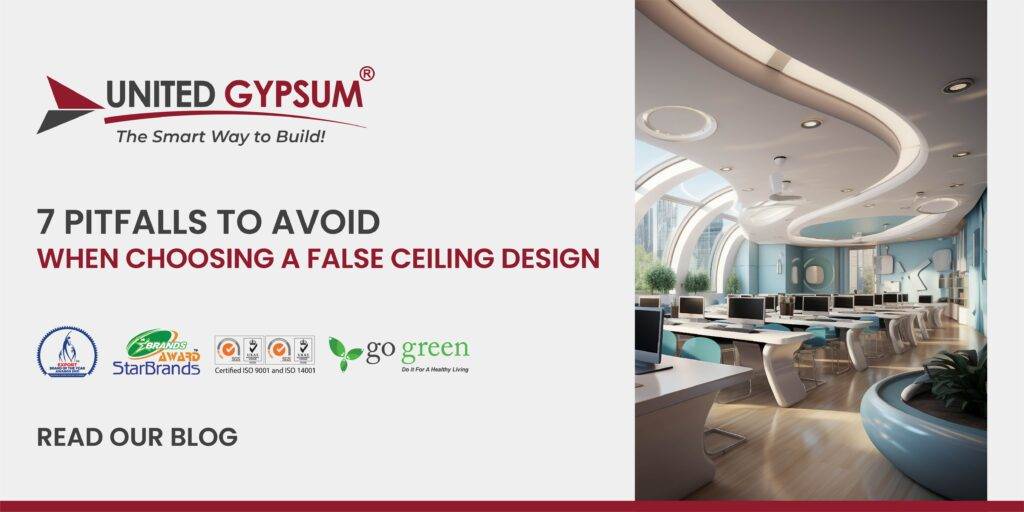When it comes to interior design, we frequently underestimate the significance of a false ceiling. A false ceiling structure refers to a secondary ceiling that is suspended from the room’s elementary ceiling. It is often referred to as a dropped ceiling or suspended ceiling. Usually, it’s put in place to enhance appearance, conceal structural components, offer insulation, or generate a visual impact.
Gypsum boards, PVC, metal, and wood are a few of the materials that may be used in the construction of false ceiling designs. They can be organized in a grid-like arrangement to form a series of panels or tiles that cover the area underneath. To fit the intended design concept, these panels might have a variety of sizes, shapes, colors, textures, and patterns.
However, choosing an unsuitable false ceiling design might have severe repercussions. Listed below are the top 7 terrible errors that individuals make when choosing a false ceiling design.
However, choosing the wrong false ceiling design can lead to disastrous consequences. Here are 7 horrible mistakes people make when selecting a false ceiling design.
1. Ignoring the room’s purpose:
One of the most common errors is opting for a false ceiling design without taking the space’s function into consideration. Individual spaces possess distinct characteristics. For instance, a living room or dining area where you want to create a light and bright atmosphere might not be an appropriate location for a low-hanging, monotonous false ceiling design.
Always consider the intended use of the space and make sure the false ceiling design complements it. One way to create an illusion of more space in a small area is to install a false ceiling with a basic, minimalistic design. On the flip side, bigger spaces allow you to experiment with more complex and intricate false ceiling choices.
2. Overlooking the height of the room:
Another costly mistake is failing to consider the height of the room when choosing a false ceiling design. Opting for a false ceiling with elaborate patterns or large, hefty elements will make a room with low ceilings seem smaller and more congested. In contrast, a high ceiling necessitates a false ceiling that offers height and dimension, so going with a plain, minimalist style would be a grave mistake in this regard.
Always pay attention to how high the ceiling is. A false ceiling design that creates the appearance of height, such as those with vertical lines or patterns, may be beneficial in a space with low ceilings. Rooms with high ceilings provide greater flexibility to experiment with large and opulent false ceiling plans.
3. Neglecting the lighting scheme:
In interior design, lighting is essential, even with false ceilings. When choosing a false ceiling design, it is essential to consider lighting requirements; otherwise, the area may appear uninviting and poorly lit. Plan the lighting arrangement ahead of time and pick a false ceiling design that coordinates well with the lighting scheme.
4. Disregarding the overall theme:
Whether the area is modern, minimalist, rustic, or classic, your false ceiling design should complement the whole aesthetic of the space. Choosing a false ceiling design that is out of sync with the existing decoration or deviating from the theme might negatively impact the space’s overall aesthetics and mood.
5. Forgetful about maintenance:
False ceilings, like any other feature in a space, requires maintenance. Nevertheless, while deciding on a design, many individuals neglect this matter. Over time, this can cause inconvenience and complications because certain false ceiling designs can be intricate and challenging to maintain or repair. Always go with a design that is simple to maintain and offers possibilities for quick access to concealed spots, such as wirings and pipelines.
6. Poor acoustic considerations:
A home theater and music studio are two examples of spaces where acoustics are essential to the architecture; the audio experience of these spaces may be greatly impacted by the false ceiling design you choose. False ceiling categories, components, and placement have each got an important influence on acoustics. Choose materials and configurations that maximize sound clarity while remaining consistent with the room’s acoustic requirements.
7. Ignoring professional guidance:
Lastly, one of the chief errors people make when choosing a false ceiling design is not consulting a professional beforehand. Professionals with expertise and training in interior design have the skills to help you make the most suitable choices.
By collaborating with professionals, you can make sure that the design of your false ceiling fulfills its intended function and fits in with your overall plan. With a keen eye for aesthetics, practicality, and structural concerns, they possess the knowledge and experience to help you choose the best false ceiling design for your area.
Ending Note:
To wrap it up, choosing a false ceiling design calls for thorough consideration and meticulous attention to detail. You can put together a harmonious, practical, and visually stunning space that you will appreciate for years to come by avoiding the aforementioned seven terrible blunders when choosing a false ceiling design. Thus, take your time, perform research, and engage with professionals before making a choice for your residence or a company atmosphere.

